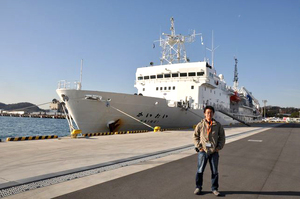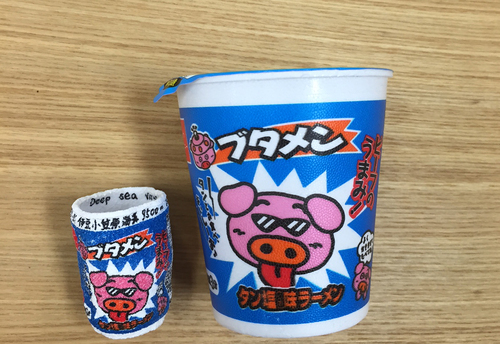ELSI Blog
114 Deeper than the deep blue sea
 What do you imagine when you hear the word "sea" or "ocean"? Sandy beaches under the sun, various marine life, or rough waves splashing on giant rocks? Well, those surely are one side of the ocean. But keep in mind that what we usually see is just the surface of the ocean. The sea below 200 m from the surface is considered as the deep sea; since this is more or less the limit at which sun light can reach. The average depth of the entire ocean is 3,729 m (according to Wikipedia), and the deepest point on earth is the Challenger Trench at 10,910 m. A major part of the ocean is way deeper than what is defined as the deep sea.
What do you imagine when you hear the word "sea" or "ocean"? Sandy beaches under the sun, various marine life, or rough waves splashing on giant rocks? Well, those surely are one side of the ocean. But keep in mind that what we usually see is just the surface of the ocean. The sea below 200 m from the surface is considered as the deep sea; since this is more or less the limit at which sun light can reach. The average depth of the entire ocean is 3,729 m (according to Wikipedia), and the deepest point on earth is the Challenger Trench at 10,910 m. A major part of the ocean is way deeper than what is defined as the deep sea.
Studying the deep sea is crucial to understanding mother earth and its ecosystem. We may observe other planets that are millions of kilometers away using telescopes in quite detail. But we cannot observe the deep sea directly. To study the world of the deep sea, we need special research vessels equipped with proper equipment.
This March, I had the privilege to join a research cruise with my JAMSTEC colleagues. It was with the research vessel "Kairei" (meaning "ocean ridge" in Japanese). This was my second research cruise, and also the second time on R/V Kairei. The main purpose of this cruise was to study the biosphere of the hadal zone; the super duper ultra deep part of the ocean. The targeted site of this cruise was the Izu-Ogasawara Trench (伊豆・小笠原海溝), with the depth of 9500 meters!
On the morning of mid-March, we took off from the JAMSTEC main port in Yokosuka. Our colleagues in JAMSTEC came to bid us "bon voyage". Japanese marine institute JAMSTEC has 8 research vessels (the most in the world for scientific vessels!), so this is rather a common scenery here. But of course it's a very special feeling when you're on the other side of the quay. After these goodbyes, no matter what, until the cruise is over, the only place we can move around is within the permitted areas of this ship, and the only people we can talk with are the people presently on board. This cruise consisted of 17 researchers and 34 ship crew. Four of the researchers were from JAMSEC, and the others were from universities all over Japan.
A research cruise is very different from boat travels. Because we need to deploy the sampling gears deep down and collect them after several hours, it is always an unavoidable battle with nature. Rather than the weather above us, what we mainly need to consider are the waves. Even when the sky is clear, if the waves are too rough, we basically can't do anything. Indeed for this cruise, it was already predicted beforehand that the waves would be too high, so we ended up spending the first and second day inside the Boso Peninsula. To be honest, we didn't have much to do for the first two days. Thanks to technological advances, now you can kill time using the internet, a big difference from my previous cruise just three years ago!
We finally got to start heading to the destination on the second evening, and arrived during midnight. Unlike the days without sampling, when we have the "go sign" from the captain, it will be a long day for us researchers. In order to gain maximum time, preparation starts very early in the morning. We were called up at 5 am. Luckily, at this sleepy point, it still is not much work for us researchers. Thanks to the ship crews, the deployment and collection of the sampling instruments will be done under good care. We just stay aside, watching silently or taking pictures.
Several hours later the instrument comes up with the samples from the super deep. That's when we get to business. During this cruise, we collected water and sediment samples from different depths. Some of the measurements need to be done right after they are brought on deck. Samples are subsampled in different containers in order to measure e.g. oxygen level, salinity, different ions etc. The group of researchers gathered for this cruise are also from different backgrounds. We all cooperate together in order to make those primary measurements and subsampling go smoothly. In the case of the sediment core samples, skilled scientists do the cutting and dividing. It was like watching a chocolatier, or the chief "taisho" at an okonomiyaki restaurant at work, using the spatula (or "hera" for okonomiyaki), cutting the dark brown chunk ... of mud. After those initial rituals, we all spread out for their own work. Well, in reality, we're still quite tightly packed because it is a small lab room in the ship after all. In my case, I had many things to do during this phase. On the days we had samplings, my lab work usually continued way past midnight. But luckily for this cruise, the "on work days" were separated with "rough wave days", so I guess I was able to get enough rest in between.
In order to do the experiments we need to do in the ship lab room, we also need to prepare every single item beforehand. Of course, even when there is something missing, you can't go back and get it. So there are a lot of things to prepare before the cruise. It's not only the small items like pipettes and plastic tubes that you need to bring in. You also need to load large lab equipment, such as autoclave, centrifuge or the pure water system etc. Loading all these were done on the day before departure. I must confess that I was not able to be there for these loadings, due to other ELSI issue, so I had to ask the generous help of my former colleagues at JAMSTEC for loading my materials.
This cruise lasted for a week. Time to time we had some rough weather, but at the end, we got mostly all the samples we initially planned. We then returned to the home port in Yokosuka. After being in a confined environment for a full week, when we got off the ship and to take our first steps back on land, it literally feels like being released. Free at last!
Oh, and of course, another very important issue. During the cruise, other than wondering if the sampling can be done or not, many people have to battle in a different way with the waves. That is the fight with the seasickness. I have had childhood experiences of getting seasick with some hours-long ferry boat trips. So before my very first research cruise, I was very worried about this, asking people around me how to deal with it. Fortunately, it turned out that I had very good compatibility with anti-motion-sickness drugs. Even the well experienced people with sickness drugs can still get seasick, so I was simply very lucky. But what I really didn't know prior to my first cruise was the post-cruise "land sickness (陸酔い)". It's what you get after getting back on land, feeling like you're still on the waves. For many, it usually goes on for 2-3 days. For me, it turned out that it lasts for about the same amount of days on the ship. So in this case, I had this very weird feeling going on for a full week.
Everybody knows that the ocean constitutes an essential part of our planet Earth. And many believe that life originated in the deep sea billions of years ago. Therefore understanding the current biosphere which is prevailing in the deep sea is very important for our studies at ELSI. I myself am a virologist. And my objective for joining this cruise was to explore the viruses in the deep sea. Viruses are the most abundant biological entities on this planet, and it is said that there are at least 10 times more viruses than cells in the ocean. Especially for those living in the deep sea, most of them are still unknown. It's still a very long road ahead, but by studying the virosphere in the ocean (and many other environments as well), we hope that someday we can have some clues on life's origin and its early evolution.












